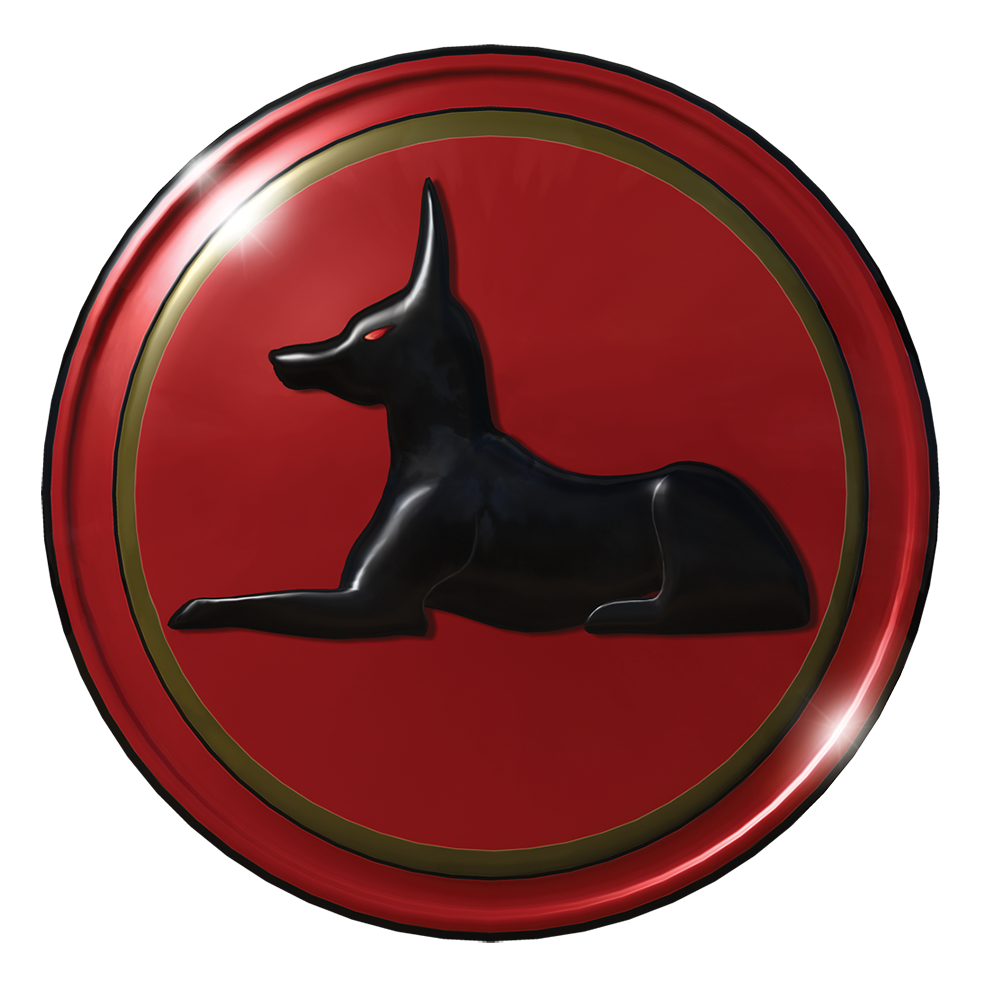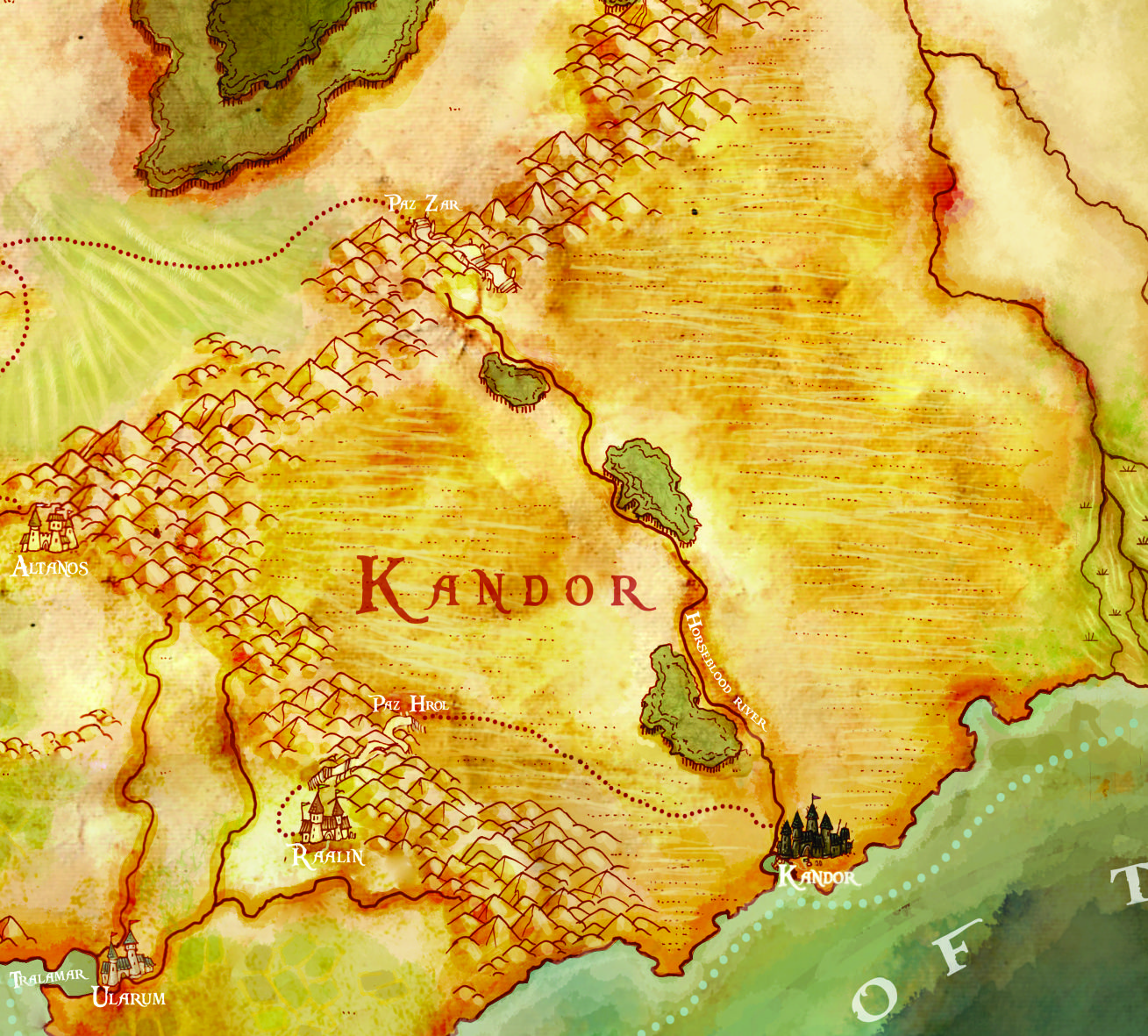The Khanate of Kandor
“Our ancestors are among us.” – Kandoran religious chantHeraldry Black jackal on red. The Jackal is the symbol of Krayech, the god of the Afterlife. The red symbolizes the red-rock desert and all the blood spilled there by the Kandoran people.
Structure
Kandor is ruled by a Khan and his male children. The Khan spends several months of the year on horseback traveling to all the prefectures (along with most of the Court). This is done to maintain tradition and to show the outer regions city life isn’t making their rulers soft.
ash-Khan (Great Khan):
Ruler of Kandor
ola-Khan (First Khan): Brother or Son of ash-Khan
Prince zeba-Khan (Second Khan):
Cousin, Nephew or Grandson of ash-Khan, Lord
The Khan is appointed by the Congress of Kra’ash and highly influenced by their summonings from the Primordial. If available, the Khan must be a male child of the previous Khan. On two occasions there were female Khans.
There is a royal court composed of military specialists, magicians from several schools, high priests, and others as the Khan sees fit. The formal military is under the Khan’s direct control. Necromancers are considered part of the military and other casters can be dragooned into service if need be.
Kandor is divided into 7 prefectures, mostly aligning with traditional tribal grounds. Each prefecture has an appointed dor-Khan. Each tribe appoints their desired dor-Khan and then is approved or disapproved by the Khan. It is customary to appoint a family member of the Khan. The dor-Khan controls the local tribal militia, which may be seized by the Khan in the event of war, otherwise is at their disposal.
History
The gorges and mesas of the Brezak Arash (sym: red-rock desert) have long been the home to Symker horsemen. Even in the days when Krai-Jan and then Traazorite traders oared slowly up the Horseblood River, they had to keep a watchful eye for horse archers sweeping along the banks. These scattered raiders, the outer fringes of the Symker peoples, never amounted to more than a nuisance until their numbers began to swell from the influx of refugees fleeing earthquakes and tsunamis in Symidia and vengeful Grular tribes. As more refugees moved into the area and as Thormenalan expansion checked any further westward movement, these tribes began to fight over ever-scarcer resources. Traazorite outposts could no longer keep the Horseblood free of them. The loss of this trade route made the continual rebuilding of the Krai-jan city of Daskarta, after repeated sackings by the nomads, pointless. For many long years after the Traazorites’ departure, the Brezak Arash roiled with skirmish and discontent and no trading vessels dared the Horseblood. The people took on a stoic and fatalistic cast. The hard land and constant warfare turned them away from worship of the full Cycle of Life and they centered their lives on the view that as hard as they had it in this world, surely Krayech would lessen their collective suffering in the next. Necromancy no longer remained the preserve of a few overeager jackal-priests; it began to enter the mainstream of people’s lives.
A major Grular incursion in 385 threatened to consume all the peoples in the area, but they united under a single khan and threw back the invaders. Although successful, the first Kandoran khan realized his people would never be safe until they faced two harsh realities: the need for political unity and the need for a stable and useful economy. Not wanting to relinquish their cultural compulsion to remain in the saddle, he hit upon a simple, if unpleasant expedient: slavery.
While slavery has long been a facet of Symker culture, this time the Kandorans sought an entirely new source, raiding the coasts of the Sunnedai jungle for Chaler slaves. Great Khan Telrat used these slaves to build the great, dark city of Kandor on Daskarta’s ruins and soon after it filled with a mix of displaced peoples, former slaves and Kandorans for whom the sedentary life was tolerable. Kandor serves as a trade center and source of national income that allows the balance of the Kandoran people to maintain their horse-based culture. Kandor City is that symbol of their new won independence; an impressive metropolis of the living and the dead along the Horseblood River.
In Y448 that city yielded a wondrous discovery–a subterranean labyrinth. Under layer upon layer of the many forms the city had taken since its early days as a part of the Krai-jan Empire, lay forgotten knowledge of necromancy once studied in secret during that decadent culture’s waning years. In these chambers, the jackal-priests found tomes and scrolls on the Primordial, incantations that accelerated their study and the results of experimentation that had taken place millennia before. Many strange and disturbing things occurred over the following years. Much of this knowledge was unsettling, but grew to acceptance due to a need for more “bodies” to work and defend against Grular. Their numbers and captured slaves were not enough. Kandor has grown to accept necromancy, even to embrace this formerly taboo magic. They have a comprehensive respect and knowledge for the Dead and are willing to use them to achieve their greatness.
The corpse is considered chattel property and may be used as slave labor or line troops. The Essence must be enticed to assist with magic of all types and usually looks forward to collaborating with the living. Channeling the Essence of fallen enemies is common to create minor magic items and provide energies for spells. Their bodies are raised as troops for Kandor’s armies. This has a distinctively disturbing effect on Kandor’s enemies—to fight their fallen comrades.
Outsiders are either repulsed or fascinated by this society. To see the Dead shuffling about among the living can be unsettling; to speak with the Essence from the Primordial can be equally unnerving, especially if there are religious taboos involved. Many think the Kandorian sorcerers are in league with dark forces from even darker realms.
Some will journey to Kandor to heal old wounds, commune with loved ones, or attempt to gain immortality. These things are possible in Kandor. Many who travel to Kandor consider its city and surrounding deserts haunted and cursed. There are many temples and hidden tabernacles where the Dead and the living mingle in esoteric and bizarre rites. Human sacrifices are said to occur to please the Dwellers of the Primordial. Slaves are best for this task…
Since 440 Kandor has been a stable, if somewhat schizophrenic, mixture of the nomadic, the urban and the unliving.
Government
Demography and Population
Mating Rituals and Customs
The Khan and royal family are polygamous. The Dwellers of the Primordial are consulted for choosing mates. A Khansha would be chosen for political reasons. Outer family members are typical for this. Other females are betrothed as concubines, which may or may not be family. Only offspring from the Khansha is considered for the Khanate, although other children are still considered royalty.
Marriages within royalty may be for love, but are usually arranged with the help of the Essence of their dead relatives. Breeding magical traits is common in the royal family line. Marriage is considered to last into the afterlife. Divorce is not possible in royal marriages.
Common marriages may be arranged for the mutual benefit of both families, or by order of the Khan as part of a breeding program, but are often the result of simple love. Dead relatives are frequently consulted on these matters. Divorce may occur if both families agree to it, which may result in compensation for one of the families.
Entertainment
Along with more mundane pursuits like horsemanship, rockclimbing, spelunking, and archaeology, Kandorans enjoy a type of arena combat unique in Faelon. Kuzkor Krex is a battle in the Necroseum in Kandor City between two necromancers and teams of animated dead gladiators they have created. As disgusting as it may seem to outsiders, Kuzkor Krex is wildly popular with all levels of Kandoran society. Visitors who protest the games too loudly sometimes end up participating in them.
What is valued by this society?
Kandorans value contact and oneness with their ancestors. Through this, they try and make their existence in this world a little better and prepare for even greater things in the next.
Territories
Military
Military
The Khan serves as the commander-in-chief and his sons, and other male relatives if necessary, serve as his generals. The Kandoran army is primarily mounted and represents some of the finest cavalry in Faelon. Their mounted archers are greatly feared. The heavy cavalry, while no match for most Faeler knights, are well trained and numerous, only closing after the light horse has worn down the foe through missile fire and feigned retreat. The city of Kandor provides a militia of heavy infantry armed with spear and bow.
The original refugees from Symidia brought the war chariot with them and Kandor still maintains a corps of the machines to break into enemy infantry phalanxes.
In war, the Kandoran army is often supplemented with the animated corpses of the recently dead.
The Kandoran navy is small and lacks heavy units. It is primarily a raiding force and usually does not go to war on its own, preferring to serve as a contingent of a larger allied navy.
Religion
The Kandorans have taken the Symker fascination with the afterlife to an extreme. While they recognize the Symker pantheon of gods, they worship Krayech, the God of Death, above all others. Many Kandoran customs and traditions surround their desire to make the next life as pleasant as possible.
Foreign Relations
View of Outsiders
Most outsiders from the west are welcomed if not tolerated, especially if they are here for trade. Outsiders are usually safe unless caught in a criminal act. Outsiders guilty of crimes within Kandor are usually sold as slaves for their punishment. Small bands of visitors have been known to disappear—the larger the group, the safer.
Thormenalans are viewed as foppish and weak due to their inferior horse skills and delicate weapons. Trillians are regarded with suspicion due to their strange appearance and that they are seen so rarely. Kandorian necromancers are curious about how a Trillian’s Essence affects their magic. So little experimentation has been done…
Grular are killed or enslaved outright, unless there was safe passage from the Khan. Trade along the border regions is tolerated.
Trade & Transport
Kandor exports ivory, livestock and, with their eastern neighbors, slaves.

Language: Symker
Type
Geopolitical, Country
Capital
Demonym
Kandoran
Currency
After the late 300’s, Kandor uses the same currency as Symidia (shown below). Prior to that, they had a barter economy, with some use of ivory pieces.
Riyal
gold
15 grams
Drachma
silver
15 grams
Shekel
bronze
15 grams
Dirhan
copper
15 grams
Official State Religion
Subsidiary Organizations
Related Professions
Related Ethnicities




Comments